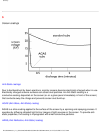
Glossary
A card equipped with a character or graphic generator and video memory, which maps to the
screen. A microprocessor scans video memory and translates bit information from the computer
into displayable video signals for the monitor. These cards comply with various standards that
determine the nature and quality of the display.
VGA (Video Graphics Array), introduced in 1987, was the first analog card. It offered still higher
resolution than EGA: 640 X 480 pixels for graphics and 720 x 400 pixels for text, and a color palette
of 256 colors. VGA could also emulate EGA and CGA.
Super VGA, devised by VESA in 1989, offers a resolution of 800 x 600 pixels.
Extended VGA, introduced by VESA in 1991, offers a top resolution of 1024 x 768 pixels (non-
interlaced) and a refresh rate slightly higher than IBM's XGA 8514A.
High-end, graphics adapters, introduced over the last three years for professional workstations,
offer top resolutions from 1280 x 1024 to 1600 x 1280, horizontal line frequencies up to 90 kHz and
bandwidths up to 200 MHz.
VIS (Viewable Image Size)
The real screen dimensions that users can see measured diagonally. The VIS of a monitor is
always less than the so called screen size of a monitor. For example, the VIS of a 17-inch monitor
is only about 16 inches. It depends on the useful screen size of CRT and the opening of a monitor's
front cabinet.
RETURN TO TOP OF THE PAGE
file:///D|/EDFU/crt_17_5/edoc/ENGLISH/GLOSSARY/GLOSSARY.HTM (22 of 22)7/15/2004 3:43:31 PM


















